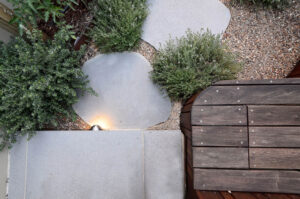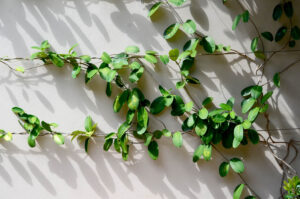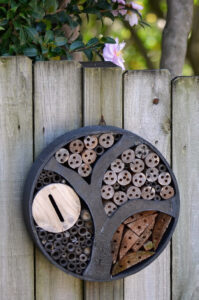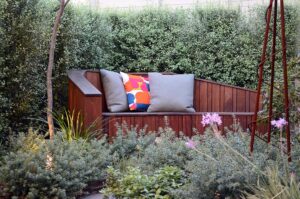Wellness Garden: The essence of flow
By Karen Lau and Steve Warner
It has long been said that gardens can heal the soul and replenish depleted spirits. For years, we have been coming together in one form or another to cultivate soil, produce food and experience a social connection. The term “therapeutic landscapes” is a great descriptive umbrella for the sense of mindfulness and restoration that can come from striking the right balance of being outdoors, getting close to nature and connecting with the community.
Most of us would agree that our life journey would benefit from the physical and mental wellbeing that a considered landscape can provide, but the design inclusions must be deliberate – we need to focus the mind so we can support the overall health of the body. The research on being in “Flow” is compelling.
Flow is a state of consciousness when the time just gently passes by and we do not worry where it has gone, because we feel entirely in the moment and have relished the activity we are engaged in.

Key elements of mindfulness

Start with a “Sense of Place” – undertake a site-specific wellness audit and understand the thread that unifies every unique space, its inclusion of individual personalities and goals, and elements that create a home rather than a house, or an experience rather than a place of routine. These outdoor spaces can transcend the everyday, creating an escape or an outlet for interest and passion.
You don’t need a quarter-acre block or the rambling grounds of an historical garden, you simply need a space that will connect to you personally. A space that you will feel safe in, where you are at peace and relaxed. Let’s take a moment and consider elements that you could connect with; ones that create a mindful approach to the here and now. This could simply be the inclusion of some well-considered items, the introduction of natural materials, and the sensitive selection of plants.
Being fully present
In your own outdoor space, communal garden, or rehabilitation garden you can strive to achieve mindfulness in a number of ways:
• Rest yourself upon a cushioned timber seat. Feel the sunshine on your face, the tactile timber under your fingers and the enduring nature of that support. Allow your legs to swing or your feet to feel grounded with the earth.
• Experience seasonal change under a deciduous tree. Watch as the autumn leaves become radiant in the sunlight and slowly float to the ground; listen as they rustle in the wind or are crunched underfoot.
• Focus your gaze on the falling water that slowly trickles down the side of a water feature, or listen as it cascades from one bowl to the next.
• Feel the calm movement of the breeze on your skin. Watch as it interacts in a tactile way with flowers or smell the scent of the blooms it carries.
All of this can be found in your own small patch of paradise, and a skilled landscape designer can deliver these in a purposeful yet non-prescriptive manner. Let’s face it, the world we live in sets high expectations, and creates pressure and anxiety. We can’t always change that, but we can invest in a new space that helps regenerate the soul.

Putting ideas and words in action – the Rehabilitation Garden Project

This particular project seeks to mimic the challenges that patients will encounter in real life, and by working with the specialist team at the hospital, each patient will be equipped with the skills and abilities needed to grasp independence, but in a safe and supporting environment.
The key function of this garden is to act as an engaging space that will replicate the experiences found for patients when they encounter our urban landscapes, from manoeuvring through traditional terrains such as curbs, steps, slopes, and gutters, to the basic need to progress from a seated to standing position.
The mobility garden is intentionally visually appealing to encourage all patients and staff to engage in a positive manner. Rehabilitation undertaken with a positive attitude will create an open mind to practice new skills and re-establish old ones. It’s also why this critical space takes the form of a seasonal garden that will ebb and flow year-round with different colours, scent, and texture.
The main winding pathways slow people down, allowing them to visually engage and be in the moment. Constructed of various materials such as pebbles, sand, step stones, and gravel, the pathways challenge mobility, whilst grade changes, grassed zones, and tree roots focus the skills needed to navigate these obstacles. People can concentrate, and must focus, on the immediate and the simple movement their bodies are required to make.
Timber platforms replicate verandas, steps and thresholds, with park benches situated to provide respite, and also a rewarding space to stop and enjoy the multitude of flowers, or take a moment under a deciduous tree that provides both shade and structure.
Key structures such as the slow-moving water feature is positioned to draw your gaze, focus your mind and centre your breathing, ready for the next moments of the challenging rehabilitation journey.

Mental wellness and physical health are often intertwined. Throughout our life, slowing down to take focus and getting ourselves into a “flow” state should not only be for when we are physically made to go for rehabilitation. Engaging in mindfulness is known to be an important brain-based strategy that enhances emotional regulation, and this can be a planned and integral part of design. They say prevention is better than cure, so maybe striving to achieve the eight dimensions of wellness is a good road map for reflection and possibility, as well as recovery.
Steve Warner
Principal Landscape Designer
Karen Lau
Senior Landscape Architect
Outhouse Design
Main Photo: Rehabilitation Garden project concept (Images supplied by OUTHOUSE Design)

